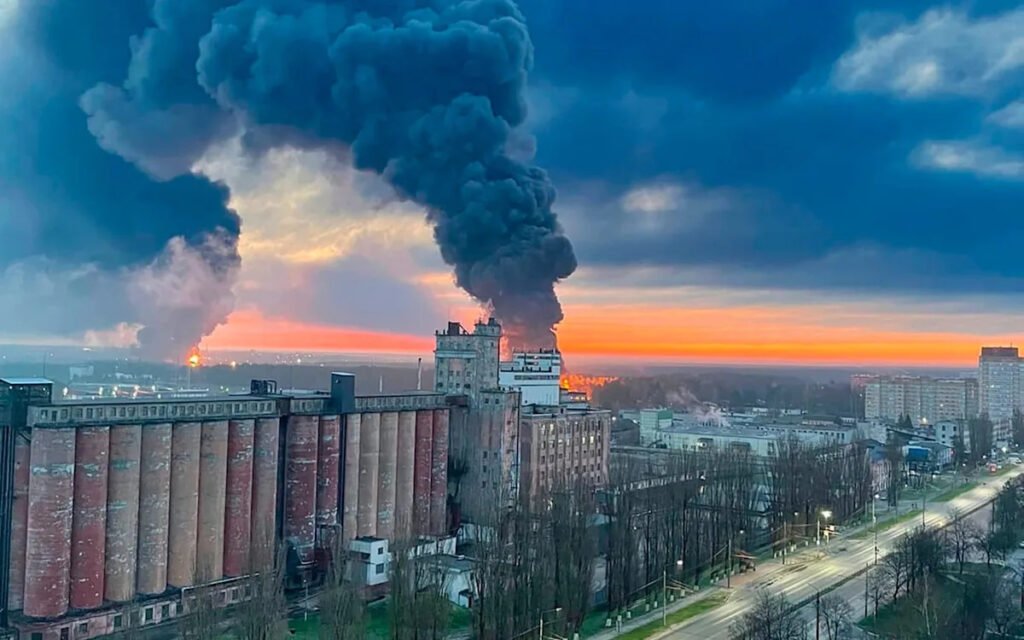The US has been helping Ukraine step up its long-range strikes on Russian energy targets in an attempt to weaken Vladimir Putin’s war effort and force him to negotiate.
For months, Washington has provided Kyiv with the intelligence needed for its intensifying aerial offensive against critical Russian refineries, pipelines and power stations, according to Ukrainian and US officials.
The intelligence-sharing, the officials told the Financial Times, has been crucial to helping Ukraine carry out the attacks since midsummer that have driven up domestic prices, cut Russian oil refining by a fifth on certain days, and led to a reduction in exports from key ports.
It is the first time Washington has been reported to have directly supported air strikes on energy facilities deep inside Russian territory – a move discouraged by the Biden administration over concerns of escalation.
The shift is viewed as a further signal of Donald Trump’s growing support for Kyiv and hardening stance towards Moscow, particularly in the wake of his failed summit with Putin in Alaska in August.
On Saturday, Volodymyr Zelensky, the Ukrainian leader, called on the US president to help broker peace in Ukraine “as he did in the Middle East”, after Israel and Hamas signed the first phase of a US-led peace deal, saying if Mr Trump could stop one war, “others can be stopped as well”.
The pair spoke again on Sunday, with Mr Zelensky hailing another “productive” conversation that included “long-range capabilities” – a suggestion that Tomahawk missiles might have been on the agenda.
“We covered all the aspects of the situation: defence of life in our country, strengthening our capabilities in air defence, resilience, and long-range capabilities,” he said in a statement, adding that Mr Trump was “well-informed”.

Volodymyr Zelensky and Donald Trump at the United Nations General Assembly in September – Anadolu/Getty
Away from the diplomatic stage, US intelligence has been helping Kyiv plot flight paths and make altitude, timing and mission decisions, enabling Ukraine’s long-range attack drones to dodge Russian air defences and reach their targets.
The US is closely involved in all stages of planning, three sources familiar with the operation told the Financial Times. A US official said Ukraine selected the targets and Washington then shared intelligence on the sites’ vulnerabilities.
The change in policy came after a phone call in July in which Mr Trump allegedly encouraged Mr Zelensky to intensify such attacks and asked whether Kyiv could hit Moscow if the US provided long-range weapons.
Ukraine hopes to strike at the core of Russia’s economy by disrupting oil and gas output, which accounts for a quarter of its GDP, while fuelling domestic discontent and forcing Putin to negotiate.
Mr Trump has been demanding that European countries reduce their dependency on Russian oil in exchange for his agreement to impose tough sanctions on Moscow.
Oil and gas revenue remains the Kremlin’s largest source of funding for the war effort, making energy exports as well as Russia’s “shadow fleet” of oil tankers a central target of Western sanctions.
The US has long shared intelligence with Kyiv that helps attacks on Russian military targets in occupied parts of Ukraine and provides advanced warning of incoming Russian missiles and drones.
Washington has still not decided whether to send Kyiv long-range weapons, including Tomahawk missiles, which have a range of 1,550 miles (2,500km) and would be capable of striking Moscow and much of western Russia.
Officials in Washington are concerned that doing so would lead to an escalation. The Kremlin has warned Mr Trump that it would destroy any remaining relationship with Washington.
Since August, at least 16 out of Russia’s 38 refineries have been hit, some repeatedly, resulting in petrol shortages across the country and prompting Moscow to cut diesel exports.
Despite causing mounting pressure for the Kremlin, analysts say the situation is still far from spiralling into a crisis that would derail Russia’s economy.
On Friday, Russia launched a large-scale attack on Ukraine’s energy grid, causing blackouts across much of the country. Moscow has targeted Ukraine’s energy infrastructure each winter since it invaded in 2022, cutting power, heating and water supplies to millions of households and disrupting water supply – actions Kyiv has condemned as war crimes.
Russian strikes on Saturday killed at least five people and left parts of the southern Odesa region without electricity, according to Ukrainian officials.
The same day, Mr Zelensky held a “very positive and productive” call with Mr Trump, congratulating him for his “outstanding” role in brokering a peace deal between Israel and Hamas.
“If a war can be stopped in one region,” Mr Zelensky said, “then surely other wars can be stopped as well, including the Russian war.”

